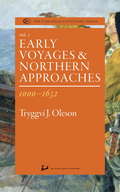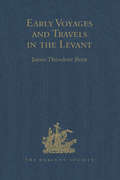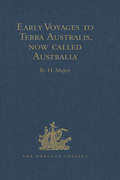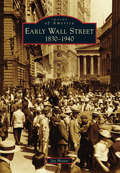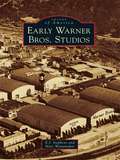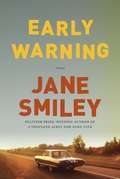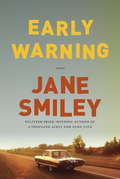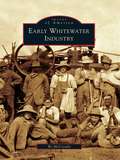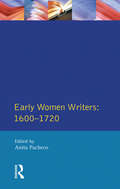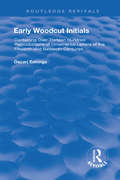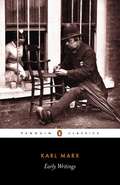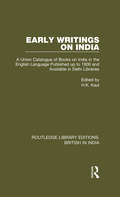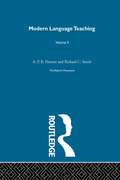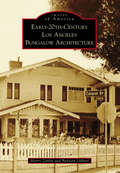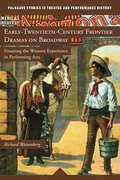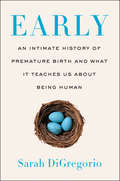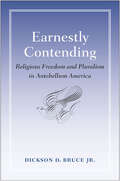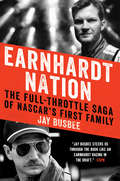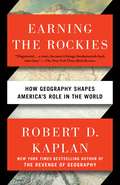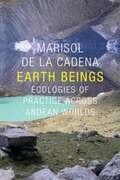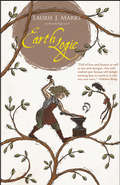- Table View
- List View
Early Voyages and Northern Approaches 1000-1632
by Tryggvi J. OlesonVolume I of the Canadian Centenary Series Now available as e-books for the first time, the Canadian Centenary Series is a comprehensive nineteen-volume history of the peoples and lands which form Canada. Although the series is designed as a unified whole so that no part of the story is left untold, each volume is complete in itself.Professor Oleson rediscovers the journeys of the Norse people from Iceland towards Arctic Canada, five hundred years before Columbus' exploits. These Christian Europeans settled with Indigenous Canadians, building stone settlements, trapping and exporting the prized white falcon and polar bear to the courts of medieval Europe, and producing the unique Thule people, ancestors of the modern Inuit. In fact, Professor Oleson's research has traced the tall white "Tunnit" people of Inuit mythology to these Norse settlers. Despite the eventual fading of contact with Europe, the Norse had built an irrefutable North Atlantic route which explorers and traders of the 17th century would follow in their pursuit of the riches of Asia and their creation of a lasting bond with Europe. First published in 1963, Tryggvi J. Oleson's important contribution to the Canadian Centenary Series is available here as an e-book for the first time.
Early Voyages and Travels in the Levant: I.- The Diary of Master Thomas Dallam, 1599-1600. II.- Extracts from the Diaries of Dr John Covel, 1670-1679. With Some Account of the Levant Company of Turkey merchants (Hakluyt Society, First Series)
by James Theodore BentThe supplementary material consists of the 1892 annual report. This is a new print-on-demand hardback edition of the volume first published in 1893 (1892).
Early Voyages and Travels to Russia and Persia by Anthony Jenkinson and other Englishmen: With some Account of the First Intercourse of the English with Russia and Central Asia by Way of the Caspian Sea
by Charles Henry Coote Edward Delmar MorganEdited from the manuscript writings of Jenkinson and other agents of the Muscovy Company in the second half of the sixteenth century, and including correspondence between Elizabeth I and Ivan IV, and reports to Cecil and the Council. Continued in First Series 73, with continuous pagination. This is a new print-on-demand hardback edition of the volume first published in 1886. Owing to technical constraints it has not been possible to reproduce the sketch map showing Anthony Jenkinson's route which appeared on p.44 of the first edition of the work.
Early Voyages to Terra Australis, now called Australia: A Collection of Documents, and Extracts from early Manuscript Maps, illustrative of the History of Discovery on the Coasts of that vast Island, from the Beginning of the Sixteenth Century to the Time of Captain Cook (Hakluyt Society, First Series)
by R. H. MajorFrom Spanish and Dutch sources and relating to Spanish and Dutch enterprises, edited, with an introduction - a separate pamphlet dated 1861 and containing an article by Major on the discovery of Australia by the Portuguese in 1601. This is a new print-on-demand hardback edition of the volume first published in 1859.
Early Wall Street: 1830-1940 (Images of America)
by Jay HosterEarly Wall Street: 1830-1940 traces the development of New York's financial district, from the low-lying city of the early 19th century, through the building boom of the 1870s and 1880s, and into the skyscraper era. A sequence of views shows 40 Wall Street as a modest three-story walk-up topped by a figure from Greek mythology, then the stately Victorian structure that replaced it, and finally, the skyscraper that missed being the tallest building in the world by a spire's length. A rare 1860s photograph captures the first New York Stock Exchange building when the marble on the exterior was still pristine. In these images, Wall Street celebrates, and Wall Street mourns. Stagecoaches clog Broadway, clipper ships dock at East River piers, and elevated trains chug through the financial district.
Early Warner Bros. Studios
by Marc Wanamaker E. J. StephensSince 1928, Warner Bros. has produced thousands of beloved films and television shows at the studio's magical 110-acre film factory in Burbank. This collection of evocative images concentrates on the Warner Bros. legacy from the 1920s to the 1950s, when timeless classics such as Casablanca, The Maltese Falcon, and East of Eden came to life. It also looks at WB's earlier homes along Hollywood's "Poverty Row," the birthplace of Looney Tunes, and the site of WB's pioneering marriage between film and sound in the 1920s. Early Warner Bros. Studios also tells the tale of four brothers--Harry, Albert, Sam, and Jack Warner--scions of a Polish Jewish immigrant family who rose from the humblest of origins to become Hollywood moguls of enormous and lasting influence.
Early Warning
by Jane SmileyFrom the Pulitzer Prize-winner: the second installment, following Some Luck, of her widely acclaimed, best-selling American trilogy, which brings the journey of a remarkable family with roots in the Iowa heartland into mid-century America<P> <P> Early Warning opens in 1953 with the Langdon family at a crossroads. Their stalwart patriarch, Walter, who with his wife, Rosanna, sustained their farm for three decades, has suddenly died, leaving their five children, now adults, looking to the future. Only one will remain in Iowa to work the land, while the others scatter to Washington, D.C., California, and everywhere in between. <P> As the country moves out of post–World War II optimism through the darker landscape of the Cold War and the social and sexual revolutions of the 1960s and ’70s, and then into the unprecedented wealth—for some—of the early 1980s, the Langdon children each follow a different path in a rapidly changing world. And they now have children of their own: twin boys who are best friends and vicious rivals; a girl whose rebellious spirit takes her to the notorious Peoples Temple in San Francisco; and a golden boy who drops out of college to fight in Vietnam—leaving behind a secret legacy that will send shock waves through the Langdon family into the next generation. <P> Capturing a transformative period through richly drawn characters we come to know and care deeply for, Early Warning continues Smiley’s extraordinary epic trilogy, a gorgeously told saga that began with Some Luck and will span a century in America. But it also stands entirely on its own as an engrossing story of the challenges—and rewards—of family and home, even in the most turbulent of times, all while showcasing a beloved writer at the height of her considerable powers.
Early Warning
by Jane SmileyFrom the Pulitzer Prize-winner: the second installment, following Some Luck, of her widely acclaimed, best-selling American trilogy, which brings the journey of a remarkable family with roots in the Iowa heartland into mid-century America Early Warning opens in 1953 with the Langdon family at a crossroads. Their stalwart patriarch, Walter, who with his wife, Rosanna, sustained their farm for three decades, has suddenly died, leaving their five children, now adults, looking to the future. Only one will remain in Iowa to work the land, while the others scatter to Washington, D.C., California, and everywhere in between. As the country moves out of post-World War II optimism through the darker landscape of the Cold War and the social and sexual revolutions of the 1960s and '70s, and then into the unprecedented wealth--for some--of the early 1980s, the Langdon children each follow a different path in a rapidly changing world. And they now have children of their own: twin boys who are best friends and vicious rivals; a girl whose rebellious spirit takes her to the notorious Peoples Temple in San Francisco; and a golden boy who drops out of college to fight in Vietnam--leaving behind a secret legacy that will send shock waves through the Langdon family into the next generation. Capturing a transformative period through richly drawn characters we come to know and care deeply for, Early Warning continues Smiley's extraordinary epic trilogy, a gorgeously told saga that began with Some Luck and will span a century in America. But it also stands entirely on its own as an engrossing story of the challenges--and rewards--of family and home, even in the most turbulent of times, all while showcasing a beloved writer at the height of her considerable powers. From the Hardcover edition.
Early Whitewater Industry
by Bo MccreadyAfter the arrival of the Milwaukee and Mississippi Railroad in 1852, Whitewater became a regional shipping center that blossomed into a powerful industrial town. The Esterly Harvesting Machine Company and the Winchester and Partridge Wagon Works established their first factories in Whitewater after the coming of the Milwaukee and Mississippi. Their manufactured goods were known around the country for exceptional quality. A myriad of new inventions and patents came from Whitewater's business population, and Whitewater's farmers and dairymen consistently won prizes for their produce, while its factories produced reapers and wagons that won national competitions. In the 1890s, however, development suddenly stopped and Whitewater lost its economic clout in a few short years. This book explains what happened to Whitewater.
Early Women Writers: 1600 - 1720 (Longman Critical Readers)
by Anita PachecoThe last twenty years have witnessed the rediscovery of a large number of women writers of the early modern period. This process of recovery has had a major impact on early modern studies for, by beginning to restore women to the history of the period, it provides new insight into the formative years of the modern era.This collection amply demonstrates the diversity as well as the literary and historical significance of early women's writing. It brings together studies by an impressive range of critics, including Elaine Hobby, Catherine Gallagher, Jane Spencer and Laura Brown, and examines the major works of five of the most important women writers of the seventeenth and early eighteenth centuries: Mary Wroth, Katherine Philips, Margaret Cavendish, Aphra Behn and Anne Finch. The range of authors it covers, and the challenging critical work it presents, make Early Women Writers: 1600-1720 essential reading for students of feminist theory, Women's Studies and Cultural Studies, as well as for all those interested in the history and literature of the early modern period.
Early Woodcut Initials: Containing Over Thirteen Hundred Reproductions of Ornamental Letters of the Fiftheenth and Sixteenth centuries, Selected and Annotated by Oscar Jennings, M.D. (Routledge Revivals)
by Oscar JenningsFirst published in 1908, Jennings collates an extensive compendium of Thirteen hundred reproductions of ornamental letters dating from the fifteenth and sixteenth centuries. Jennings in this book also provides a history into woodcutting, detailing empirical places that marked important moments in the crafts history.
Early Writings
by Karl MarxWritten in 1833-4, when Marx was barely twenty-five, this astonishingly rich body of works formed the cornerstone for his later political philosophy. In the Critique of Hegel's Doctrine of the State, he dissects Hegel's thought and develops his own views on civil society, while his Letters reveal a furious intellect struggling to develop the egalitarian theory of state. Equally challenging are his controversial essay On the Jewish Question and the Economic and Philosophical Manuscripts, where Marx first made clear his views on alienation, the state, democracy and human nature. Brilliantly insightful, Marx's Early Writings reveal a mind on the brink of one of the most revolutionary ideas in human history - the theory of Communism.This translation fully conveys the vigour of the original works. The introduction, by Lucio Colletti, considers the beliefs of the young Marx and explores these writings in the light of the later development of Marxism.
Early Writings on India: A Union Catalogue of Books on India in the English Language Published up to 1900 and Available in Delhi Libraries (Routledge Library Editions: British in India #7)
by H. K. KaulThis book, first published in 1975, is a comprehensive list of all the books on India, written in English before 1900. It is an invaluable reference source on India of the eighteenth and nineteenth centuries. Apart from the work of professional writers, there are the writings of a cross-section of society from soldiers to scientists. We find dictionaries of obscure dialects written by government officials, descriptions of their travels by visiting clerics, homely details of everyday life by housewives, as well as technical and scientific works written by scholars.
Early Years of Reform (Logos Studies in Language and Linguistics)
by Richard C. Smith A. P. R. HowattThis volume forms part of a five volume set charting the progress of the nineteenth century movement, which was instrumental in establishing international guidelines for the teaching of modern languages. It was during this period that for the first time, co-operation between phoneticians and teachers culminated in the publication of works that were instrumental in establishing the 'applied linguistic' approach to language teaching in the twentieth century. For the first time, too, the new science of psychology influenced a scientific theory of second language acquisition. The Reform Movement attracted support across Europe, spurring the development of new professional associations and journals. In turn, the publication in these journals of reports of innovative practice contributed to a greater sense of autonomy and professionalism among modern language teachers, who had hitherto tended to live under the shadow of classical language teaching. The practical innovations and theoretical suggestions for the foreign language teaching, although rooted in the nineteenth century, still have relevance today.
Early-20th-Century Los Angeles Bungalow Architecture (Images of America)
by Harry Zeitlin Bennett GilbertLos Angeles, California, shaped the nation's culture in the 20th century with the city's bungalow style of mass middle-class housing. The style made the novelty and easy climate of Los Angeles into a force for living according to new standards of health and well-being, freedom and openness, and simple artistry. The bungalow combined the cozy appeal of Arts and Crafts design with what became the basic principles of 20th-century house architecture: earth-hugging lines, visible structure, and open floor plans emphasizing warmth, intimacy, and fluidity. While the streets and neighborhoods of the "bungalowtown" presented a lively panorama in which each house stood out as an individual, the bungalow was also a dream that the real estate industry sold to exploit the hunger for upward mobility that brought hundreds of thousands of new residents to the city during the three decades of the popularity of the style. Some of the neighborhoods that the developers established failed, and many homes were eventually demolished or in advanced decay. Yet today, these old houses are beautiful and comfortable homes when restored.
Early-Twentieth-Century Frontier Dramas on Broadway
by Richard WattenbergFrontier dramas were among the most popular and successful of early-twentieth-century Broadway type plays. The long runs of contemporary dramas not only indicate the popularity of these plays but also tell us that these plays offered views about the frontier that original audiences could and did embrace.
Early: An Intimate History of Premature Birth and What It Teaches Us About Being Human
by Sarah DiGregorio“Sarah DiGregorio delves deeply into the fraught world of premature birth. With bracing honesty, she recounts her own story and the stories of other women who draw on the power of love and meld it with cutting-edge science, as they struggle to save the lives of their newborns. This book opens our minds and hearts to a world that is rarely seen with such clarity.”—Jerome Groopman, MD, Recanati Professor at Harvard Medical School and author of The Anatomy of HopeInspired by the author’s harrowing experience giving birth to her premature daughter, a compelling and empathetic work that combines memoir with rigorous reporting to tell the story of neonatology—and to meditate on the questions raised by premature birth. The heart of many hospitals is the Neonatal Intensive Care Unit (NICU). It is a place where humanity, ethics, and science collide in dramatic and deeply personal ways as parents, doctors, and nurses grapple with sometimes unanswerable questions: When does life begin? When and how should life end? And what does it mean to be human?Nearly twenty years ago, Dr. John D. Lantos wrote The Lazarus Case, a seminal work on ethical dilemmas in neonatology. He described the NICU as “a strong, strange, powerful place.” The NICU is a place made of stories—the stories of mothers and babies who spend days, weeks, and even months waiting to go home, and the dedicated clinicians who care for these tiny, developing humans. The book explores the evolution of neonatology and its breakthroughs—how modern medicine can be successful at saving infants at five and a half months gestation who weigh less than a pound, when only a few decades ago, there were essentially no treatments for premature babies.For the first time, Sarah DiGregorio tells the complete story of this science—and the many people it has touched. Weaving her own story, those of other parents, and NICU clinicians with deeply researched reporting, Early delves deep into the history and future of neonatology, one of the most boundary pushing medical disciplines: how it came to be, how it is evolving, and the political, cultural, and ethical issues that continue to arise in the face of dramatic scientific developments. Eye-opening and vital, Early uses premature birth as a lens to view our own humanity, and the humanity of those around us.
Earnestly Contending: Religious Freedom and Pluralism in Antebellum America
by Dickson D. Bruce Jr.In Earnestly Contending, Dickson Bruce examines the ways in which religious denominations and movements in antebellum America coped with the ideals of freedom and pluralism that exerted such a strong influence on the larger, national culture. Despite their enormous normative power, these still-evolving ideals—themselves partly religious in origin—ran up against deeply entrenched concerns about the integrity of religious faith and commitment and the role of religion in society. The resulting tensions between these ideals and desires for religious consensus and coherence would remain unresolved throughout the period.Focusing on that era’s interdenominational competition, Bruce explores the possibilities for and barriers to realizing ideals of freedom and pluralism in antebellum America. He examines the nature of religion from the perspectives of anthropology and cognitive sciences, as well as history, and uses this interdisciplinary approach to organize and understand specific tendencies in the antebellum period while revealing properties inherent in religion as a social and cultural phenomenon. He goes on to show how issues from that era have continued to play a role in American religious thinking, and how they might shed light on the controversies of our own time.
Earnhardt Nation: The Full-Throttle Saga of NASCAR's First Family
by Jay BusbeeEarnhardt Nation is a fearless portrait of the larger-than-life first family of NASCAR and the rise of the world’s fastest stock car racing organization.“Jay Busbee steers us through the book like an Earnhardt racing in the draft.” —ESPNMore than sixty years ago, Ralph Earnhardt toiled in a cotton mill in his native North Carolina to support his growing family. Weekends he could be found going pedal to the metal at the dirt tracks, taking on the competition in the early days of box car racing and becoming one of the best short-track drivers in the state. His son, Dale Earnhardt, Sr., would become one of the greatest drivers of all time, and his grandson Dale Jr., would become NASCAR’s most popular driver of the 2000s. From a simple backyard garage, the Earnhardts reached the highest echelons of professional stock car racing and became the stuff of myth for fans.Earnhardt Nation is the story of this car racing dynasty and the business that would make them rich and famous—and nearly tear them apart. Covering all the white-knuckle races, including the final lap at the Daytona 500 that claimed the life of the Intimidator, sports writer Jay Busbee goes deep into the fast-paced world of NASCAR, its royal family’s obsession with speed, and their struggle with celebrity. He looks deep inside the lives of these men and women who shaped NASCAR, delving into their personal and professional lives, from failed marriages to rivalries large and small to complex and competitive father-son relationships that have reverberated through generations, and explores the legacy the Earnhardts struggle to uphold.
Earning the Rockies: How Geography Shapes America's Role in the World
by Robert D. KaplanAn incisive portrait of the American landscape that shows how geography continues to determine America’s role in the world—from the bestselling author of The Revenge of Geography and Balkan GhostsAs a boy, Robert D. Kaplan listened to his truck-driver father tell evocative stories about traveling across America in his youth, travels in which he learned to understand the country literally from the ground up. There was a specific phrase from Kaplan’s childhood that captured this perspective: A westward traveler must “earn the Rockies” by driving—not flying—across the flat Midwest and Great Plains. In Earning the Rockies, Kaplan undertakes his own cross-country journey to recapture an appreciation of American geography often lost in the jet age. Traveling west, in the same direction as the pioneers, Kaplan traverses a rich and varied landscape that remains the primary source of American power. Along the way, he witnesses both prosperity and decline—increasingly cosmopolitan cities that thrive on globalization, impoverished towns denuded by the loss of manufacturing—and paints a bracingly clear picture of America today. The history of westward expansion is examined here in a new light—as a story not just of genocide and individualism, but also of communalism and a respect for the limits of a water-starved terrain, a frontier experience that bent our national character toward pragmatism. Kaplan shows how the great midcentury works of geography and geopolitics by Bernard DeVoto, Walter Prescott Webb, and Wallace Stegner are more relevant today than ever before. Concluding his journey at Naval Base San Diego, Kaplan looks out across the Pacific Ocean to the next frontier: China, India, and the emerging nations of Asia. And in the final chapter, he provides a gripping description of an anarchic world and explains why America’s foreign policy response ought to be rooted in its own geographical situation. In this short, intense meditation on the American landscape, Robert D. Kaplan reminds us of an overlooked source of American strength: the fact that we are a nation, empire, and continent all at once. Earning the Rockies is an urgent reminder of how a nation’s geography still foreshadows its future, and how we must reexamine our own landscape in order to confront the challenges that lie before us. Advance praise for Earning the Rockies“A text both evocative and provocative for readers who like to think . . . In his final sections, Kaplan discusses in scholarly but accessible detail the significant role that America has played and must play in this shuddering world.”—Kirkus Reviews“Earning the Rockies is a brilliant reminder of the impact of America’s geography on its strategy. An essential complement to his previous work on the subject of geostrategy, Kaplan’s latest contribution should be required reading.”—Henry A. Kissinger “Robert D. Kaplan uses America’s unique geography and frontier experience to provide a lens-changing vision of America’s role in the world, one that will capture your imagination. Unflinchingly honest, this refreshing approach shows how ideas from outside Washington, D.C., will balance America’s idealism and pragmatism in dealing with a changed world. A jewel of a book, Earning the Rockies lights the path ahead.”—General (Ret.) James Mattis
Earth Beings: Ecologies of Practice across Andean Worlds
by Robert J. Foster Marisol de la Cadena Daniel R. ReichmanEarth Beings is the fruit of Marisol de la Cadena's decade-long conversations with Mariano and Nazario Turpo, father and son, runakuna or Quechua people. Concerned with the mutual entanglements of indigenous and nonindigenous worlds, and the partial connections between them, de la Cadena presents how the Turpos' indigenous ways of knowing and being include and exceed modern and nonmodern practices. Her discussion of indigenous political strategies--a realm that need not abide by binary logics--reconfigures how to think about and question modern politics, while pushing her readers to think beyond "hybridity" and toward translation, communication that accepts incommensurability, and mutual difference as conditions for ethnography to work.
Earth Gods: Writings from before the War (Harvard Library of Ukrainian Literature #14)
by Taras ProkhaskoEarth Gods presents the early writings of Taras Prokhasko, one of Ukraine’s most prominent contemporary writers. Collected here for the first time in one book, these works span various genres yet form a single chronicle. Anna’s Other Days, Prokhasko’s first publication, testifies to the desire to free Ukrainian culture of overt influences of voices, styles, and genres that have dominated it for centuries. FM Galicia collects reflections delivered by the author at a Ukrainian radio show over a five-month period. Emphasizing the relevance of the oral genre as the origin of the text, Prokhasko has created a unique diary that strives to exist outside of literature and invites the reader to meditate on the human condition. The UnSimple—a novel whose action unfolds between the two world wars near Ialivets, in the Ukrainian Carpathian Mountains—documents the collapse of the grand narratives of the past, embodied here by the Carpathian earth gods who, despite their magical powers, are unable to save the patriarchal community they’ve been entrusted with from being overrun by the forces of modernization.A master of reflexive, finely nuanced prose, Prokhasko weaves together narrative strands testifying to the sophistication and integration of Ukrainian culture with the world.
Earth History Resources: Images,Data and Readings
by Associates FOSS Middle School Project StaffScience Reader
Earth Logic
by Laurie J. MarksThe second book of Shaftal. The country has a ruler again, Karis, a woman who can heal the war-torn land and expel the invaders. But she lives in obscurity with her fractious found family. With war and disease spreading, Karis must act. And when Karis acts, the very stones of the earth sit up and take notice.
Earth Matters on Stage: Ecology and Environment in American Theater (Routledge Studies in Theatre, Ecology, and Performance)
by Theresa J. MayEarth Matters on Stage: Ecology and Environment in American Theater tells the story of how American theater has shaped popular understandings of the environment throughout the twentieth century as it argues for theater’s potential power in the age of climate change. Using cultural and environmental history, seven chapters interrogate key moments in American theater and American environmentalism over the course of the twentieth century in the United States. It focuses, in particular, on how drama has represented environmental injustice and how inequality has become part of the American environmental landscape. As the first book-length ecocritical study of American theater, Earth Matters examines both familiar dramas and lesser-known grassroots plays in an effort to show that theater can be a powerful force for social change from frontier drama of the late nineteenth century to the eco-theater movement. This book argues that theater has always and already been part of the history of environmental ideas and action in the United States. Earth Matters also maps the rise of an ecocritical thought and eco-theater practice – what the author calls ecodramaturgy – showing how theater has informed environmental perceptions and policies. Through key plays and productions, it identifies strategies for artists who want their work to contribute to cultural transformation in the face of climate change.
